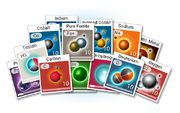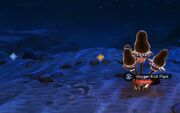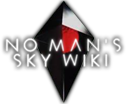| The subject of this article is from the NEXT update.
The information from this article is up-to-date as of 28 October, 2018. |
The information from this article is up-to-date as of 28 October, 2018.

| This article is about the NEXT version of Resource. For the Atlas Rises version, see Resource (Atlas). |
Resources are the primary materials for multi-tool, starship, exosuit and exocraft upgrades, as well as base building.
Summary
Resources in No Man's Sky are organized as Raw Materials in the in-game Guide based on type. When resources are mined, they are broken down into their chemical elements, and these can be combined into new products to be sold on the galactic market.
Technology is dependent on certain elements, so collecting element resources and alloys can unlock new multi-tools, starships, etc.
Resources can be obtained in a wide variety of ways. They can be purchased, mined from raw elements on the ground of planets (either by hand or with an Autonomous Mining Unit), mined from asteroids in space, harvested from plants, collected from the air (with an Atmosphere Harvester or Oxygen Harvester), given to you as gifts from animals you befriend, found in crates and containers on planet surfaces, and harvested by killing plants, animals and even sentinels. The abundance of elements varies significantly from one planet to another, and some resources are easiest to obtain in specific ways.
Resources may also be converted into other resources with the use of the three different sized refiners.
Scanning

Scanner "diamonds"
When the scanner is used on a planet, diamonds of red, yellow, blue, green, and purple are displayed after the scan. These colors represent the location of elements belonging to the element groups indicated below. Resources of common rarity will not have the diamond markers. All mineable nodes (chunks of minerals in rock form) will have grids outlining the parts that will give resources when mined. Nodes that do not have grids DO NOT give resources when mined.
Scanning rock formations, fauna, crystals and flora with the Analysis Visor can reveal secondary resources, which can then be mined on all other instances of that scanned object. Flora are the plants and trees on a planet. Fauna means the animals. When you engage the scanner and look at an animal, a red or green dot will appear. Red means undiscovered and you should scan it. Green means discovered already. This dot does not appear when you look at flora. When you have scanned a new species of animal the scanner will reward you with a small cash bonus. Then open the menu and go to Discoveries. Here you upload all of your discoveries and are rewarded with Nanite Clusters. A wise traveller would visit a Space Station and buy an S class scanner upgrade which boosts your cash bonus considerably.
Elements
| Icon | Element | Abbrev | Group | Rarity | Base value units | Added |
|---|---|---|---|---|---|---|
| File:Substance.fuel.common1.png | Carbon | C | Organic | Common | 7.0 | 1.0 |
 |
Condensed Carbon | C+ | Organic | Uncommon | 24.0 | 1.5 |
| File:Substance.Oxygen.png | Oxygen | O2 | Organic | Common | 34.0 | 1.5 |
 |
Hexite | X | Organic | Uncommon | 654.0 | 1.59 |
 |
Di-hydrogen | H | High Energy | Common | 34.0 | 1.5 |
| File:Substance.Deuterium.png | Deuterium | D | High Energy | Rare | 34.0 | 1.5 |
 |
Tritium | H3 | High Energy | Common | 6.0 | 1.5 |
 |
Ferrite Dust | Fe | Metallic | Common | 14.0 | 1.5 |
 |
Pure Ferrite | Fe+ | Metallic | Uncommon | 28.0 | 1.5 |
 |
Magnetised Ferrite | Fe++ | Metallic | Rare | 82.0 | 1.5 |
| File:Substance.Sodium.png | Sodium | Na | Catalytic | Common | 41.0 | 1.5 |
| File:Substance.SodiumNitrate.png | Sodium Nitrate | Na+ | Catalytic | Uncommon | 82.0 | 1.5 |
| File:Substance.Cobalt.png | Cobalt | Co | Subterranean | Common | 198.0 | 1.5 |
| File:Substance.IonisedCobalt.png | Ionised Cobalt | Co+ | Subterranean | Uncommon | 401.0 | 1.5 |
| File:Substance.Salt.png | Salt | NaCl | Aquatic | Uncommon | 299.0 | 1.5 |
| File:Substances.Chlorine.png | Chlorine | Cl | Aquatic | Rare | 602.0 | 1.5 |
 |
Cyto-Phosphate | Cy | Organic Compound | Common | 201.0 | 1.7 |
 |
Copper | Cu | Stellar | Uncommon | 110.0 | 1.0 |
| File:Substance.Cadmium.png | Cadmium | Cd | Stellar | Uncommon | 234.0 | 1.5 |
 |
Emeril | Em | Stellar | Uncommon | 275.0 | 1.0 |
| File:Substance.Indium.png | Indium | In | Stellar | Uncommon | 464.0 | 1.5 |
 |
Chromatic Metal | Ch | Stellar | Uncommon | 245.0 | 1.5 |
| File:Substance.Paraffinium.png | Paraffinium | Pf | Localised | Uncommon | 62.0 | 1.5 |
 |
Pyrite | Py | Localised | Uncommon | 62.0 | 1.5 |
| File:Ammonia.png | Ammonia | NH3 | Localised | Uncommon | 62.0 | 1.5 |
| File:Substance.Uranium.png | Uranium | U | Localised | Uncommon | 62.0 | 1.5 |
| File:Substance.Dioxite.png | Dioxite | C02 | Localised | Uncommon | 62.0 | 1.5 |
| File:Substance.Phosphorus.png | Phosphorus | P | Localised | Uncommon | 62.0 | 1.5 |
| File:Substance.neutral.rare15.png | Mordite | Mo | Harvested | Uncommon | 40.0 | 1.1 |
| File:Substance.neutral.rare5.png | Pugneum | Pg | Anomalous | Rare | 138.0 | 1.1 |
| File:Substance.Silver.png | Silver | Ag | Asteroid | Common | 101.0 | 1.5 |
 |
Gold | Au | Asteroid | Uncommon | 202.0 | 1.0 |
 |
Platinum | Pt | Asteroid | Rare | 303.0 | 1.0 |
 |
Sulphurine | Su | Gas | Uncommon | 20.0 | 1.3 |
 |
Radon | Rn | Gas | Uncommon | 20.0 | 1.3 |
| File:Substance.Nitrogen.png | Nitrogen | N | Gas | Uncommon | 20.0 | 1.3 |
 |
Activated Copper | Cu | Stellar | Rare | 245.0 | 1.5 |
 |
Activated Cadmium | Cd | Stellar | Rare | 450.0 | 1.5 |
 |
Activated Emeril | Em | Stellar | Rare | 696.0 | 1.5 |
 |
Activated Indium | In | Stellar | Rare | 949.0 | 1.5 |
| File:Substance.neutral.rare11.png | Fungal Mould | Fm | Agricultural | Uncommon | 16.0 | 1.1 |
| File:Substance.neutral.rare13.png | Frost Crystal | Fc | Agricultural | Uncommon | 12.0 | 1.1 |
| File:Substance.neutral.rare8.png | Gamma Root | Gr | Agricultural | Uncommon | 16.0 | 1.1 |
| File:Substance.neutral.rare4.png | Cactus Flesh | Cc | Agricultural | Uncommon | 28.0 | 1.1 |
| File:Substance.neutral.rare7.png | Solanium | So | Agricultural | Uncommon | 70.0 | 1.1 |
| File:NmsResource Star Bulb icon.png | Star Bulb | Sb | Agricultural | Uncommon | 32.0 | 1.3 |
| File:Substance.neutral.rare3.png | Marrow Bulb | Mb | Agricultural | Uncommon | 41.0 | 1.1 |
| File:Substance.neutral.rare9.png | Kelp Sac | Ke | Agricultural | Uncommon | 41.0 | 1.1 |
| File:Substance.neutral.rare14.png | Coprite | Cr | Agricultural | Uncommon | 30.0 | 1.1 |
| File:Residualgoopicon.png | Residual Goop | Jn | Junk | Common | 20.0 | 1.3 |
| File:Runawaymould.PNG | Runaway Mould | Jn | Junk | Uncommon | 20.0 | 1.3 |
| File:Rustedmetalicon.png | Rusted Metal | Jn | Junk | Common | 20.0 | 1.3 |
| File:NmsLiving Slime Icon.png | Living Slime | Jn | Junk | Uncommon | 20.0 | 1.3 |
| File:Viscousfluidsicon.png | Viscous Fluids | Jn | Junk | Uncommon | 20.0 | 1.3 |
Resource Deposits
Resource Deposits are concentrated nodes of a certain element.
- Stellar metal nodes (Copper, Cadmium, Emeril and Indium) and their activated variants have a metallic color and are shaped like a really rough half-sphere. They have the same colors as the metals they contain.
- Certain localised elements (Paraffinium, Ammonia, Dioxite and Phosphorus) can generate as resource deposits on specific planet types which are similar in shape to those of stellar metals.
- Other elements (Silver, Gold, Pure Ferrite, and Sodium) may generate as resource deposits on any planet.
It is possible to find bigger nodes which contain more elements than usual. There's a chance that those nodes can be marked by scanning in space with a spaceship.
Crystals
Some elements can also be found in crystalline form, showing up on the Scanner. The color of the crystal indicates which element is present.
- Blue crystals are Di-hydrogen. Common.
- Red crystals contain Condensed Carbon. Uncommon.
- Yellow crystals are composed of Sodium Nitrate. Uncommon.
Plants
Some elements can be found as compounds in certain plants on planet surfaces:
- Carbon (can also be found by killing animals)
- Sodium (old Zinc plants)
- Platinum
- Oxygen (old Thamium9 plants)
- Marrow Bulb (in caves)
- Star Bulb (on lush worlds)
- Cactus Flesh (on desert worlds)
- Gamma Root (on radioactive worlds)
- Fungal Mould (on toxic worlds)
- Frost Crystal (on frozen worlds)
- Solanium (on hot worlds)
- Kelp Sac (underwater)
Additionally, these elements can be collected from fauna interactions, but can also be farmed:
Additional information
- During an interview with Sean Murray, he was asked how far down you can dig. Sean said "you can dig like 128 meters down into a planet." [1] This sets a limit on how deep mining and exploration can take place.
- When art director Grant Duncan wanted the possibility of green skies over a planet, the development team at Hello Games had to redesign the periodic table to create atmospheric particles that would diffract light at just the right wavelength.
- Sean Murray commented during a gameinformer interview, "We just wanted to be a bit freer. There's only something like seven different compounds or something like that that we create really good types of liquids that you could have creatures survive in. And we might want more than that for the game. We might want to decide our own rules and you just get tied up into too many conversations about it and things like that. Sometimes gameplay and science don't sync together. That's sort of a shame but I think for the best."[2]
- In-game guide added in the NEXT update, which includes Raw Material classification of the resources, see screenshots below.
Release history
- NEXT - This update massively changed most resources in the game, either by removing them entirely, renaming them, or giving them new uses. Resources in inventories from old saves will be replaced by the new ones once they are updated. Refer to the Atlas Rises version of the Resource page for more information on these original elements.
- NEXT 1.59 - Hexite added as part of Community Research (week 2) mission.
- Abyss - Cyto-Phosphate added to some underwater plants.
Gallery
References
- ↑ Giant Bombcast (23 June 2015). 'Giant Bombcast - 1:10:00 mark'.
- ↑ Vore, Bryan (26 December 2014). [www.gameinformer.com/b/features/archive/2014/12/26/an-assortment-of-lesser-known-no-man-s-sky-facts.aspx An Assortment Of Lesser-Known No Man's Sky Facts]. gameinformer. Retrieved 19 July 2016.
| ||||||||||||||||||||||||||


